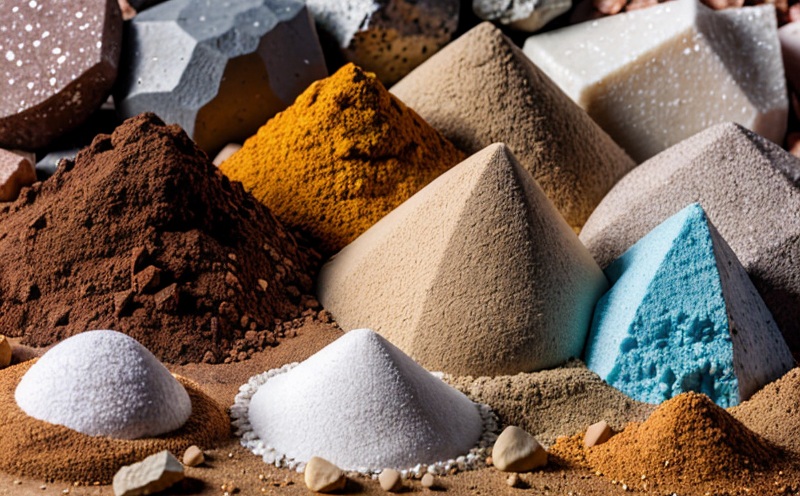Gravimetric Moisture Determination in Ores Testing
The gravimetric method of moisture determination is a widely recognized technique used to assess the water content within ores and minerals. This process involves drying a sample in an oven at specified temperatures until no further weight change occurs, from which the percentage moisture can be calculated. The gravimetric method ensures accurate measurement by removing all forms of volatile matter, including water, thus providing a reliable assessment of the sample's composition.
The technique is particularly important for industries such as mining and metallurgy, where precise knowledge of mineral content can influence production processes, quality control measures, and ultimately profitability. In ore testing, moisture levels are critical because they affect the stability of the material during processing stages, its reactivity with other chemicals, and the overall efficiency of extraction operations.
For accurate gravimetric analysis, proper sample preparation is essential. Typically, samples are sieved to ensure homogeneity before being weighed on a sensitive balance. The oven used for drying must be capable of maintaining precise temperature control within narrow limits; ISO 11269-5:2014 specifies the requirements for ovens intended for gravimetric moisture determination.
The choice of temperature is crucial in this process, as it directly affects both the drying time and the final moisture content reading. Common temperatures range from 105°C to 135°C depending on the type of ore being analyzed. For instance, metals like copper or zinc ores may require higher temperatures due to their lower boiling points compared to silica-based materials.
Once dried, samples are weighed again to calculate the percentage moisture lost during drying. This value is then used along with other analytical data from the same sample to determine overall ore quality and purity. Understanding these parameters helps companies optimize their operations by identifying areas where improvements could be made or efficiencies gained.
A significant advantage of gravimetric methods lies in their repeatability; multiple operators using the same procedure should consistently obtain similar results, making it easier for laboratories across different locations to compare findings. Additionally, this method does not alter the chemical composition of the sample beyond removing water molecules, preserving its integrity throughout testing.
Compliance with international standards like ISO 11269-5:2014 ensures that all moisture determinations adhere to recognized best practices globally, enhancing confidence among clients and stakeholders. By adhering strictly to these guidelines, our laboratory maintains high levels of accuracy and reliability in its testing services.
Our expertise extends beyond mere execution; we also offer comprehensive consultation on how best to apply this technique within your specific operational framework. Our team works closely with customers to understand their unique requirements before recommending suitable approaches tailored specifically for them.
Customer Impact and Satisfaction
Implementing gravimetric moisture determination in ores testing has numerous benefits for mining companies seeking to improve efficiency, reduce costs, and enhance product quality. By accurately measuring the moisture content of their raw materials at various stages of processing, businesses can optimize their production processes more effectively.
- Improved Efficiency: Knowing the exact amount of water present allows operators to adjust temperature settings during drying steps appropriately, reducing energy consumption without compromising on accuracy.
- Better Product Quality: Consistent moisture levels contribute significantly towards maintaining uniform product quality throughout batches. This consistency leads to higher customer satisfaction and better market positioning.
- Cost Reduction: Precise measurements help minimize waste by ensuring that only necessary amounts of water are present in the final product, thereby lowering production costs while increasing profitability.
The implementation of gravimetric moisture determination also fosters greater transparency within supply chains. Through detailed reports generated from our testing processes, customers gain insight into every stage of ore handling and processing, promoting trust between suppliers and buyers alike.
Competitive Advantage and Market Impact
- Innovation Leadership: By staying abreast of advancements in gravimetric moisture determination techniques, our laboratory remains at the forefront of industry trends. This enables us to offer state-of-the-art solutions that give clients a competitive edge.
- Regulatory Compliance: Adherence to international standards ensures that all tests conducted meet stringent quality benchmarks set by regulatory bodies worldwide. This compliance not only helps companies avoid penalties but also enhances their reputation among regulatory authorities and consumers alike.
- Predictive Analytics: Leveraging data gathered through repeated gravimetric analyses allows for predictive modeling of future performance trends. Understanding these patterns enables proactive decision-making aimed at maximizing operational efficiency.
The ability to provide reliable, accurate moisture content figures contributes significantly towards establishing trust with key stakeholders including investors, regulators, and end-users. This builds long-term relationships that benefit both parties involved in the supply chain.
Through continuous innovation and commitment to excellence, we strive to maintain our position as leaders in gravimetric moisture determination services within the mining sector. Our goal is always to deliver superior service that meets or exceeds client expectations while driving positive change across the industry.
Use Cases and Application Examples
The application of gravimetric moisture determination spans multiple aspects of the mining lifecycle, from exploration through extraction and processing. Here are some specific use cases:
- Exploration Phase: Evaluating surface samples to identify potential areas rich in valuable minerals.
- Preliminary Analysis: Assessing bulk samples collected during drilling campaigns to guide further sampling efforts more effectively.
- Processing Optimization: Monitoring moisture levels throughout various stages of crushing, grinding, and separation processes to fine-tune operation parameters.
- Quality Control: Ensuring consistent moisture content in final products destined for sale or export markets.
In each case, accurate measurement plays a pivotal role in achieving desired outcomes. For example, understanding the moisture levels within crushed ores can help optimize ball mill efficiency, leading to better particle size distribution and overall throughput rates.
Another crucial application involves tailings management where reducing excess water content enhances storage capacity while minimizing environmental impact associated with seepage into surrounding ecosystems. By applying gravimetric methods early in the process, potential issues can be addressed proactively rather than reactively once they become apparent later down the line.





